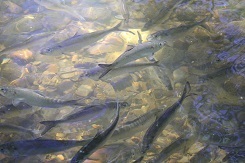Free-Flowing Tributary Streams: Grants and Projects; Resilient Hudson Shoreline Designs Webinar
The New York State Department of Environmental Conservation sent this bulletin on 11/17/2020 11:24 AM EST |
| DEC Delivers - Information to keep you connected and informed from the NYS Department of Environmental Conservation |
| Share or view as a web page || Update preferences or unsubscribe |
Hudson RiverNet
|
In This Issue:
Restoring Free-Flowing Waters in Hudson Tributary Streams
DEC grant funding helps communities assess and replace these barriers. More than $855,000 recently was awarded to four projects to help reduce local flooding and restore aquatic habitats in tributary streams of the Hudson River Estuary. These funds will support projects to restore free-flowing waters to benefit water quality and restore aquatic habitat connectivity for Species of Greatest Conservation Need, including the American eel and river herring. The grants were provided through DEC’s Environmental Protection Fund. Read more about the projects in DEC’s press release.
Resilient Hudson River Shoreline Designs Webinar November 20This webinar will present the preliminary designs for sustainable shoreline projects in Kingston and Piermont, New York. Both communities participated in the Climate-Adaptive Design Studio, a program that links Cornell University graduate and undergraduate students in landscape architecture with flood-prone communities on the Hudson to create design concepts that incorporate projections for sea-level rise and extreme weather. In collaboration with each municipality, design and engineering firms selected and developed a design concept for two vulnerable shorefront locations. In Piermont, HDR Engineering prepared a preliminary design for a living shoreline project that emphasizes protection and stabilization of existing shorelines and development of shallow water habitat while providing recreational access to the Hudson. In Kingston, SuperMass Studio created a design to stabilize the shoreline, create habitat, and reinforce the beach at Kingston Point. Representatives of the municipalities and the design firms will discuss the process of stakeholder engagement and present the site assessments, design objectives, conceptual plans, and permitting considerations. The webinar will take place Friday, November 20 from 2 p.m. to 3:30 p.m. For more information and to register, visit the webpage for the Sustainable Shorelines Designs Webinar Series.
|

 Fresh water river and stream habitats are linked to the estuary through a network of
Fresh water river and stream habitats are linked to the estuary through a network of 
